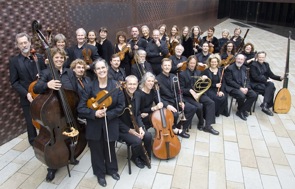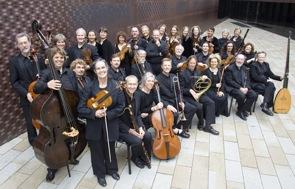
Concerto grosso ... Vivaldi’s Four Seasons ... “Pre-classic” music — these terms are probably enough to send a seasoned classical music fan running for the hills. They tend to conjure up advertising soundtracks, bargain basement recordings, and, above all, generic interpretations. But put this repertoire in the hands of expert interpreters and a seasoned period-instrument orchestra, and it soon becomes apparent why 18th-century audiences were hungry for orchestral repertoire by the bucket load.
The Philharmonia Baroque Orchestra and Music Director Nicolas McGegan breathed life into this music, in richly satisfying and often surprising ways, in San Francisco’s Herbst Theatre on Friday night. Their program opened with a concerto by Corelli from his Opus 6 set. Corelli may not have invented the concerto grosso, but he was probably the first composer to use the term in any formal way. His concertos also set the standard by which future concerti grossi were judged. The orchestra opened with one of the concertos that follow the sonata da camera (chamber sonata) model, a type of piece that consists of various dance movements. Although Corelli’s concertos of this type are ostensibly based on lighter dance movements than the more formidably contrapuntal concertos after the sonata da chiesa (church sonata) model, Corelli can never quite refrain from generating beautiful, imitative structures. McGegan coaxed a remarkably transparent sound from the ensemble, and all that delicate interplay came across with unusual clarity and finesse.
Next on the docket was a Sinfonia by Giovanni Battista Pergolesi, one of those composers who has the misfortune of being famous in name yet rarely played. This Sinfonia was worlds away from the heady counterpoint of the Corelli concerto. I sometimes refer to this music as gestural — three-quarters of the way to the tuneful, periodic phrasing of the Classical era, but still rooted in the aesthetics of an older generation. The opening movement was full of flitting little gestures that McGegan treated like a musical kaleidoscope; with each sudden change in musical shape, the orchestra adopted a new dynamic, a shift in articulation patterns, a subtly different tempo. The second movement, lyrical and lilting, proved a shocking contrast; if the first movement was in a highly evolved Baroque orchestral language, the second movement was proto-Haydn. Here, and throughout the Sinfonia, Pergolesi came across as the young, precociously brilliant composer he was, and PBO’s tantalizing taste left me yearning to hear more.
Getting the Blumenstock Treatment
The centerpiece of the evening was Antonio Vivaldi’s most famous collection, The Four Seasons. Violinist Elizabeth Blumenstock took center stage for these four overplayed works. She and the orchestra managed to turn what might have proved a boringly familiar set into something fresh and new through a wonderful process of defamiliarization, without the slightest hint of eccentricity or tackiness. I particularly enjoyed the transparent textures of the second movement of the “Spring” concerto. In this movement, and elsewhere in the set, the group proved just how delicately and quietly an ensemble can play, to magical effect. The final movement was a rollicking good time, with the orchestra doing everything it could to evoke windy bagpipes and grinding hurdy-gurdies in this pleasantly rustic finale.
Blumenstock truly shone in the opening movement of “Summer.” From her first solo section, she obviously relished the same freedom that Vivaldi embraced when deciding to base these concertos on little descriptive sonnets, thereby freeing him from the need for overbearingly organized structural principles. When the music in “Summer” demanded fast, furious playing, Blumenstock happily obliged with her reliably fiery technique. Still, the most affecting moments in the performance were those strange chromatic meanderings that serve as sharp contrast to the more virtuoso bits. Blumenstock luxuriated in the strangeness of these gestures, slowing the tempo to eke out every last ounce of dissonance from the melodic augmented seconds and other exotic intervals that dot the line. The effect was mesmerizing.
Out of the Dim Past, Brightly
Equally strange and wonderful was the second movement of “Autumn,” which was treated to a little improvised harpsichord duet between Hanneke van Proosdij, who provided a swirling arpeggio pattern, and McGegan, whose right hand wasn’t always audible in Herbst Theatre, but which seemed to be producing some free counterpoint with the sustained violin lines that slither around harmonically. This innovative approach was emblematic of their approach to the set as a whole: fascinatingly unpredictable.
Equally unpredictable and unfamiliar were concertos by rarely heard composers Lorenzo Zavateri and Francesco Durante. The former was a Bolognese musician whose D-Major Concerto “à Pastorale” may have been a tad conservative in its compositional approach, but which was at least expertly constructed — and expertly performed. The opening movement was a lovely Corellian grave, with a “walking bassline” and aching suspensions in the upper parts. It provided another opportunity for the orchestra to explore the delicate, crystalline sound that characterized so much of the evening’s performance. Throughout the rest of the piece, violinists Carla Moore and Katherine Kyme, sitting on opposite sides of the stage, tossed imitations back and forth like a couple of old friends indulging in a bit of one-upmanship. By the end of the set I found myself grinning ear to ear.
Durante’s piece was stylistically worlds apart from everything else on the program, except perhaps the Pergolesi. The first movement was gestural music par excellence, with brief little tunes strung together in a binary structure. The second movement was hauntingly beautiful, though at times a bit sparse, sounding almost like an opera aria missing its vocal line. The final movement was a furious allegro, a mad dash to the finish filled with swirling scalar figures, which McGegan and his band tossed off with wit and enthusiasm.
This concert managed to blend familiar and unfamiliar into a thoroughly enjoyable whole. Between a veritable revitalization of Vivaldi’s Four Seasons and some expertly rendered performances of lesser-known works, this concert alone was enough to remind listeners why Philharmonia Baroque remains the premier American ensemble for performances of 18th-century music.

